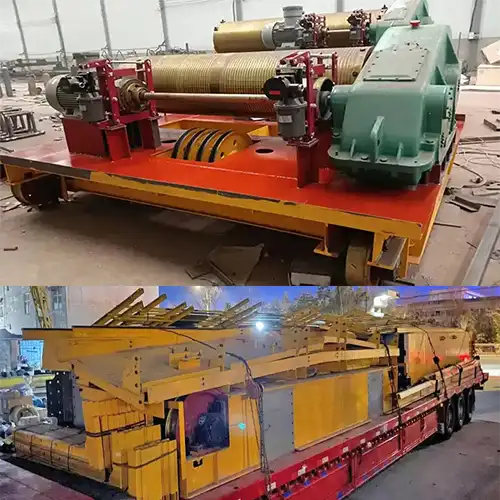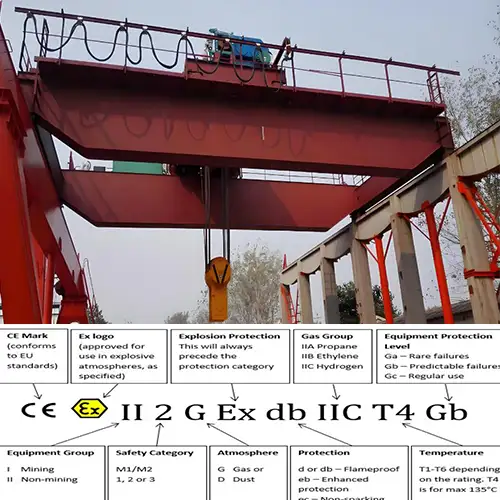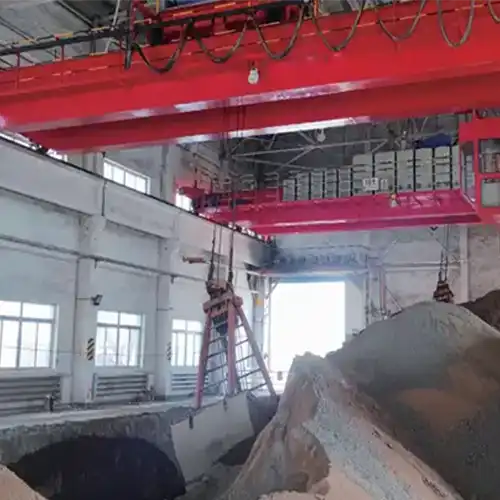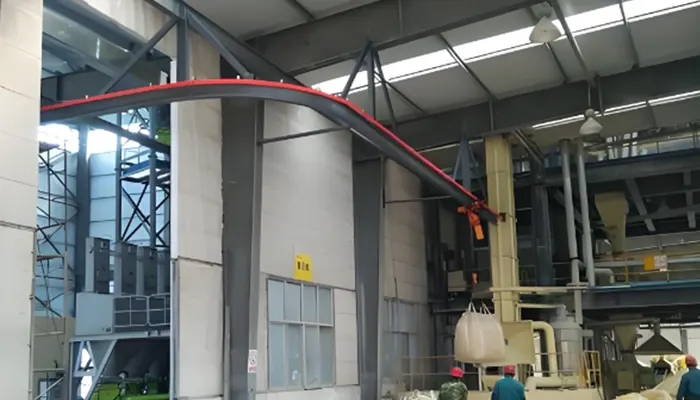
Monorail Lift System : Overhead monorail with hoist Systems for Large-Scale Industrial Workshops
Monorail lift systems provide efficient overhead material handling solutions, optimizing workflows in large-scale workshops and industrial facilities at lower costs.
Monorail Lift Systems
Monorail lift systems are innovative material handling solutions designed to efficiently transport loads across various industrial environments. These systems typically consist of a single rail mounted overhead, allowing hoists to move along the rail with ease. Monorail lifts can be equipped with different types of hoists, such as electric hoists, chain hoists, and manual hoists, making them versatile for diverse applications.
Importance of Efficient Material Handling in Large Facilities
In large-scale workshops and industrial facilities, effective material handling is crucial for maintaining productivity and safety. Monorail lift systems significantly enhance operational efficiency by streamlining the movement of heavy loads, reducing the need for manual labor, and minimizing the risk of workplace injuries. By utilizing these systems, companies can achieve the following benefits:
- Increased productivity through faster load transportation
- Enhanced safety by reducing manual handling
- Improved space utilization in facilities with limited floor space
Understanding Overhead Monorail Hoist Systems
What are Monorail Hoist Systems?
Monorail hoist systems are specialized material handling solutions that consist of a single rail suspended overhead, along which a hoist moves to lift and transport loads. These systems are designed to operate efficiently in various industrial environments, providing a streamlined method for handling materials.
Basic Components of Monorail Lifting Systems
A typical monorail hoist system includes several essential components:
- Monorail Track: The overhead rail that supports the movement of the hoist. It can be straight or curved, allowing for versatile layouts within a facility.
- Hoist: The lifting device that attaches to the monorail track. It can be powered electrically or operated manually, depending on the specific requirements of the application.
- Trolley: This component allows the hoist to move along the monorail track smoothly, enabling the transportation of loads to various workstations.
- End Stops: These safety features prevent the trolley from rolling off the end of the track, ensuring safe operation.
Types of Monorail Hoists
Monorail hoists come in various types to suit different lifting needs:
- Monorail Electric Hoist: Ideal for heavy lifting tasks, this type of hoist uses an electric motor to lift and lower loads efficiently. It is known for its speed and ease of use.
- Monorail Chain Hoist: This manual or electric hoist uses a chain mechanism to lift loads. It is particularly useful for environments where power supply may be limited.
Benefits of Using Monorail Systems
The use of monorail hoist systems offers numerous advantages, making them a popular choice in large-scale workshops and industrial facilities:
Space Utilization
Monorail systems are designed to be installed overhead, which helps maximize floor space. By elevating lifting operations, businesses can free up valuable ground area for other processes, enhancing overall productivity.
Flexibility in Design
Monorail hoist systems can be customized to fit the specific layout and requirements of any facility. They can accommodate various rail configurations, allowing for straight or curved paths, which can adapt to different workflow needs.
Improved Safety
Safety is paramount in any industrial setting. Monorail hoist systems enhance safety by reducing the need for manual lifting and lowering of heavy loads. Additionally, the overhead design minimizes obstacles on the floor, creating a safer working environment and reducing the risk of accidents.
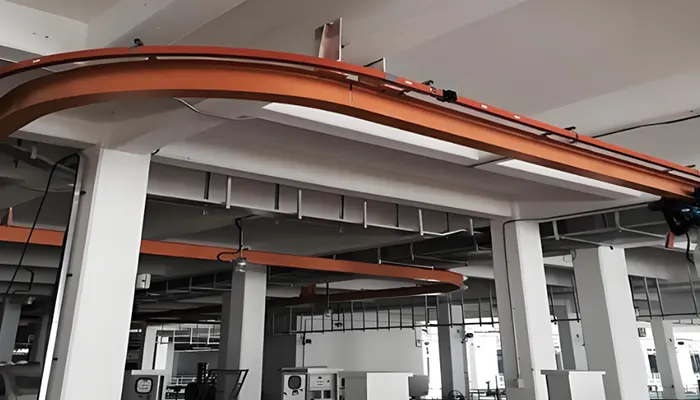
Key Features of Overhead Monorail Hoist Systems
Load Capacity and Performance
Overhead monorail hoist systems are designed to handle various loads, making them suitable for different industrial applications.
Various Load Capacities
Monorail hoists come in multiple load capacities to accommodate different lifting needs. Common options include:
- 1 Ton Monorail Hoist: Suitable for lighter lifting tasks, often used in small workshops or for specific applications where weight limits are lower.
- 3 Ton Monorail Hoist: Ideal for medium-duty lifting tasks, providing versatility in handling heavier loads typical in larger industrial environments.
Performance Metrics of Monorail Electric Hoists
Electric monorail hoists are known for their performance and efficiency. Key performance metrics include:
- Lifting Speed: Electric hoists typically offer faster lifting and lowering speeds compared to manual hoists, improving workflow efficiency.
- Duty Cycle: This refers to the hoist's ability to operate over extended periods without overheating. High-quality electric hoists are designed for frequent use and can maintain consistent performance throughout their operational life.
Travel Length and Speed
One of the significant advantages of monorail hoist systems is their ability to cover long distances, facilitating the movement of materials across extensive workshop spaces.
Long Travel Capabilities
Monorail systems can be designed to accommodate long travel lengths, allowing for the transportation of materials across large facilities. This capability is particularly useful in environments where the production process involves moving items between different workstations.
Adjustable Speeds for Efficiency
Monorail hoists often come with adjustable speed settings, enabling operators to control the lifting and traveling speeds based on the specific needs of the task. This flexibility helps optimize efficiency and enhances safety during operations.
Monorail Lifting Systems: Traveling Path Flexibility
Monorail lifting systems offer unique advantages when it comes to traveling paths. They can be configured to follow both curved and straight paths, allowing for versatile material handling across various applications and environments.
- Curved Paths: Monorail systems can seamlessly navigate around obstacles and adapt to the layout of the facility. This is particularly beneficial in workshops with complex configurations, as it maximizes space utilization while maintaining efficient workflow.
- Straight Paths: For longer spans, monorail systems can be set up in straight lines, enabling efficient transportation of materials over extended distances.
Comparison with Other Systems
Rail-Travelling Overhead Cranes
- Flexibility: Overhead cranes are typically limited to straight paths, which may restrict flexibility in facilities with intricate layouts. Monorail systems can better accommodate various building configurations through their curved path capabilities.
- Space Utilization: Monorail systems often take up less vertical space than traditional overhead cranes, which can be advantageous in low-ceiling environments.
Rail Travelling Gantry Cranes
- Mobility: Gantry cranes are often designed for outdoor applications and may lack the precision of monorail systems in indoor settings. Monorail systems can be installed in tight spaces and adapted for specific workflows, offering better versatility.
- Footprint: Monorail lifting systems typically have a smaller footprint than gantry cranes, which require more space for their support legs. This compact design is advantageous in crowded environments.
Non-Rail Traveling Portable Cranes
- Versatility: While portable cranes offer mobility, they generally lack the defined traveling paths that monorail systems provide. Monorails are fixed, which enables more consistent and predictable material handling.
- Operational Efficiency: Monorail systems are usually more efficient for repetitive tasks since they can be designed to optimize travel paths for specific workflows, unlike portable cranes, which may require manual repositioning.
Monorail lifting systems excel in providing flexible traveling paths—both curved and straight—enhancing their adaptability for various material handling needs. Compared to rail-traveling overhead cranes, gantry cranes, and non-rail traveling portable cranes, monorail systems offer unique advantages in terms of space utilization, operational efficiency, and versatility. This makes them a cost-effective and practical solution for large-scale workshops and industrial facilities looking to optimize their material handling processes.
Control Systems
The control system is a crucial aspect of overhead monorail hoist systems, impacting both usability and safety.
Manual vs. Automated Control Options
Monorail hoist systems can be operated using different control mechanisms:
- Manual Control: Some monorail hoists are operated manually, allowing users to have direct control over lifting and movement. This option is often more economical and suitable for smaller operations.
- Automated Control: Advanced systems feature automated controls, which can include remote operation or programmable settings. This option enhances efficiency and allows for precise load handling in complex environments.
Safety Features in Control Systems
Safety is a priority in any material handling system. Monorail hoist control systems often incorporate several safety features, such as:
- Emergency Stop Buttons: Easily accessible emergency stops allow for immediate cessation of operation in case of an emergency.
- Overload Protection: Many systems include overload sensors that prevent operation when the load exceeds the hoist's rated capacity, reducing the risk of equipment failure and ensuring safe lifting practices.
Applications in Large-Scale Workshops and Industrial Facilities
Manufacturing and Assembly Lines
Overhead monorail hoist systems play a pivotal role in enhancing efficiency within manufacturing and assembly environments. Their design facilitates the smooth movement of materials and components throughout the production process.
Streamlining Production Processes
Monorail hoists enable the seamless transportation of components along assembly lines. By integrating these systems, manufacturers can significantly reduce handling times and minimize delays, leading to faster production cycles.
- Reduced Downtime: Continuous material flow minimizes interruptions in the assembly process, ensuring that production targets are met efficiently.
- Ergonomic Benefits: By utilizing monorail systems for lifting and transporting heavy items, workers experience reduced physical strain, leading to improved safety and productivity.
Heavy Lifting Tasks with Monorail Hoist and Trolley
Monorail hoists combined with trolleys provide an effective solution for heavy lifting tasks on the assembly floor.
- Versatile Load Handling: This combination allows for the lifting and movement of various components, from lightweight parts to heavier assemblies, enhancing operational flexibility.
- Optimized Space Utilization: With the ability to maneuver loads overhead, floor space is freed up for other operations, contributing to a more organized workspace.
Warehousing and Distribution
In warehousing and distribution centers, monorail hoist systems facilitate efficient material handling, ensuring timely delivery and organization of inventory.
Efficient Inventory Management
Monorail systems assist in managing inventory by allowing for easy access to stored items.
- Centralized Transportation: Hoists can move goods from one location to another, streamlining the picking and packing processes.
- Increased Throughput: By efficiently transporting materials, warehouses can handle higher volumes of goods, reducing bottlenecks.
Quick Retrieval and Transportation
The design of monorail hoists enables rapid retrieval and transportation of products, essential in fast-paced warehouse environments.
- Time-Saving Features: With adjustable speeds and automation, retrieving items becomes quicker, significantly reducing the time spent on logistics.
- Improved Workflow: Enhanced movement of goods supports a smoother operation, enabling workers to focus on value-added tasks rather than manual handling.
Automotive and Heavy Equipment
In the automotive and heavy equipment sectors, overhead monorail hoist systems are indispensable for moving large and heavy components with precision.
Moving Large Components with Monorail Hoist Track Systems
These systems are engineered to accommodate the specific demands of the automotive industry, ensuring that heavy components can be moved efficiently.
- Robust Load Capacity: Monorail hoist track systems are designed to handle the weight of large automotive parts, making them suitable for tasks such as engine assembly or chassis construction.
- Versatile Applications: They can be utilized throughout various stages of production, from initial assembly to final inspection.
Custom Solutions for Specialized Tasks
Monorail hoist systems can be tailored to meet the unique requirements of specific applications in the automotive and heavy equipment sectors.
- Adaptability: Custom solutions may include specialized attachments or configurations designed to handle unique lifting challenges, enhancing operational efficiency.
- Integration with Existing Systems: These hoists can be integrated into existing workflows, ensuring compatibility with current production lines and processes, thereby maximizing return on investment.
Economic Advantages of Overhead Monorail Hoist Systems
Cost-Effectiveness Compared to Traditional Systems
Overhead monorail hoist systems present a compelling economic advantage when compared to traditional material handling solutions. The combination of reduced operational costs and increased productivity makes these systems an attractive investment for large-scale workshops and industrial facilities.
Initial Investment vs. Long-Term Savings
While the initial investment in monorail hoist systems may be significant, the long-term savings can be substantial.
- Return on Investment: Monorail systems typically lead to lower operating costs over time due to their efficiency and reliability. Businesses can expect a favorable ROI as the systems enhance productivity and minimize downtime.
- Energy Efficiency: Many modern monorail hoists are designed to consume less energy than traditional lifting solutions, contributing to reduced utility bills and a smaller environmental footprint.
Reduced Labor Costs with Monorail Winches
The automation and ease of use of monorail hoists, particularly with winch systems, help to lower labor costs significantly.
- Less Manual Handling: By mechanizing the lifting and transporting of materials, businesses can minimize the need for manual labor, thereby reducing labor costs and associated worker compensation expenses.
- Increased Throughput: With monorail systems streamlining material handling, workers can focus on more productive tasks, further enhancing overall efficiency and cost-effectiveness.
Maintenance Considerations
When evaluating the economic advantages of overhead monorail hoist systems, maintenance costs play a crucial role.
Low Maintenance Requirements for Monorail Chain Blocks
Monorail hoist systems are designed for durability and ease of maintenance, which translates into lower maintenance costs over time.
- Simplified Maintenance: Monorail chain blocks require less frequent maintenance than many traditional lifting systems. This is due to their robust construction and the use of high-quality materials, which minimize wear and tear.
- Quick Repairs: When maintenance is needed, the accessibility of components in monorail systems allows for quicker repairs, reducing downtime and associated costs.
Reliability and Longevity of Monorail Hoist Manuals
Monorail hoist systems are engineered for reliability, resulting in a longer lifespan and lower overall costs.
- Durable Construction: The robust design of monorail hoists ensures they can withstand the rigors of daily use in demanding industrial environments, leading to fewer replacements and lower long-term costs.
- Consistent Performance: Reliable performance means businesses can count on monorail hoist systems to operate efficiently without frequent interruptions, enhancing productivity and reducing the likelihood of costly downtimes.
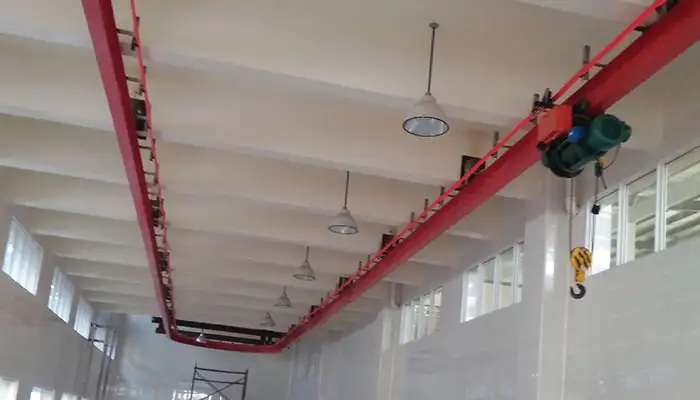
Installation and Space Considerations
Installation Process of Monorail Hoist Systems
Successfully implementing a monorail hoist system in large-scale workshops or industrial facilities involves a well-structured installation process. This process ensures that the system operates efficiently and safely.
Planning and Design
The planning phase is crucial for the effective installation of monorail hoist systems.
- Site Assessment: Conduct a thorough assessment of the facility to determine the best location for the monorail system. Factors such as ceiling height, load capacities, and available space should be considered.
- Design Layout: A detailed layout is essential to optimize the use of the monorail system. This includes mapping out the travel paths, identifying potential obstacles, and determining the positioning of hoists and trolleys to facilitate efficient material handling.
Installation Challenges and Solutions
While installing monorail hoist systems, various challenges may arise. However, these can be managed effectively with proper planning.
- Structural Considerations: The existing structure must support the weight and operational demands of the monorail system. Reinforcement may be required, particularly in older facilities.
- Electrical and Safety Systems: Ensuring that electrical systems are compatible and that safety measures, such as emergency stops and safety guards, are integrated into the installation process is vital for safe operation.
Space Requirements and Layout Flexibility
Monorail hoist systems are highly adaptable, making them suitable for a variety of facility layouts. Their efficient use of space is one of their key benefits.
Adapting to Facility Layouts
The ability to adapt to different facility layouts is crucial for maximizing the effectiveness of a monorail hoist system.
- Customizable Designs: Monorail systems can be tailored to fit various building configurations, allowing for flexible installation in narrow aisles or expansive open areas.
- Integration with Existing Equipment: Monorail hoists can be integrated into existing workflows and systems, ensuring minimal disruption during installation and enhancing overall efficiency.
Optimizing Workflow with Monorail Lifts
Using monorail lifts can significantly enhance the workflow within a facility.
- Streamlined Material Handling: By optimizing the layout of the monorail system, materials can be moved more efficiently, reducing the time spent on handling tasks and increasing overall productivity.
- Flexible Workstations: Monorail lifts can create flexible workstations that can be easily reconfigured to accommodate changes in production needs, thus allowing businesses to adapt quickly to evolving demands.
Case Studies and Real-World Examples
Successful Implementations in Various Industries
Monorail hoist systems have been successfully implemented across a range of industries, demonstrating their versatility and effectiveness in enhancing material handling processes.
Automotive Industry
In the automotive sector, a large manufacturing facility implemented a monorail electric hoist system to streamline assembly processes.
- Enhanced Production Efficiency: By utilizing a monorail hoist with a capacity of 3 tons, the facility improved its assembly line speed, significantly reducing the time taken to lift and position heavy components.
- Custom Solutions: The monorail system was designed to accommodate specific production workflows, allowing for quick adjustments and modifications to meet changing demands.
Manufacturing Sector
A leading manufacturing company adopted a monorail lifting system to optimize its warehouse operations.
- Space Optimization: The installation of a monorail chain hoist system allowed the company to maximize vertical space, freeing up floor area for additional inventory storage.
- Reduced Labor Costs: By automating material handling with monorail lifts, the company minimized the need for manual lifting, resulting in lower labor costs and improved worker safety.
Aerospace Industry
In the aerospace industry, a major aircraft manufacturer integrated a monorail hoist system into its assembly line.
- Precision Handling: The monorail system was equipped with adjustable speeds and advanced control features, enabling precise lifting and placement of sensitive components.
- Compliance with Standards: The implementation adhered to strict safety regulations, showcasing how monorail systems can meet industry-specific requirements.
Lessons Learned from Installation and Operation of Monorail Electric Hoists
Effective Planning is Crucial
- Thorough Site Assessment: Conducting detailed assessments prior to installation helps identify potential challenges and ensures that the system is tailored to the facility's specific needs.
- Collaboration with Experts: Engaging with experienced professionals during the planning and installation process can significantly enhance the effectiveness of the monorail system.
Maintenance is Key to Longevity
- Regular Inspections: Implementing a routine maintenance schedule for monorail hoists ensures that any issues are identified and addressed promptly, extending the system's lifespan.
- Training for Operators: Providing comprehensive training for operators on the safe and efficient use of monorail hoists is essential for maximizing performance and minimizing risks.
Flexibility and Adaptability
- Scalability: Monorail hoist systems can be expanded or modified as business needs change, allowing companies to remain agile in a dynamic market.
- Custom Solutions: The ability to tailor monorail systems to specific applications ensures that businesses can optimize their operations for maximum efficiency.
Conclusion
Overhead monorail hoist systems offer a robust solution for enhancing material handling in large-scale workshops and industrial facilities. Their key features, including high load capacity, customizable travel lengths, and efficient control systems, make them ideal for a variety of applications across different industries.
- Versatile Applications: From manufacturing and automotive to aerospace and warehousing, monorail hoist systems streamline operations and improve productivity.
- Economic Advantages: They provide significant cost savings through reduced labor costs and low maintenance requirements, making them a smart investment for businesses.
- Ease of Installation and Adaptability: Monorail systems can be integrated into various facility layouts, optimizing workflows and utilizing vertical space effectively.
Final Recommendations for Choosing Overhead Monorail Hoist Systems
When selecting an overhead monorail hoist system, consider the following recommendations:
- Assess Load Requirements: Evaluate the load capacities needed for your operations, ensuring that the system can handle the heaviest components efficiently.
- Consider Travel Length and Speed: Choose a system that meets your operational speed requirements and has the capability for long travel distances.
- Evaluate Control Options: Decide between manual and automated control systems based on your facility's needs, focusing on safety features and user-friendliness.
- Consult with Experts: Engage with industry professionals to get insights on the best systems suited for your specific applications.
Encouragement for Further Research and Expert Consultation
Investing in an overhead monorail hoist system is a significant decision that can greatly impact your operations. Therefore, it is crucial to conduct thorough research and seek expert advice.
- Explore Advanced Technologies: Keep an eye on advancements in monorail hoist technology, such as smart controls and automated systems, which can enhance efficiency further.
- Network with Industry Peers: Join industry groups and forums to learn from others' experiences and gain insights into the best practices for implementing monorail systems.
- Request Demonstrations: Whenever possible, arrange for demonstrations of different monorail hoist systems to see their functionality and suitability firsthand.
By taking the time to research and consult with experts, you can ensure that your investment in overhead monorail hoist systems leads to enhanced productivity and operational efficiency in your facility.
